August 31, 2019
By age 23, Teresa Earles had turned her body into a powerful machine.
The personal trainer from St. John's could leg press 105 pounds.
She could do 25 push-ups in a row.
She could squat with 140 pounds on her shoulders, despite weighing just 127 pounds herself.
But on Aug. 26, 2017, all it took was a few bites of a lunchtime burrito to break her.
Earles found herself in such intense pain at the gym she had to phone her mother to drive her to the hospital.
Keeled over, she told the ER doctor: "There is something going on in my stomach here."
After sending her for X-rays, the doctor returned with some news:
"You are full of shit," he said. "You are literally full of shit."
The doctor explained that her digestive system had basically stopped working and prescribed a liquid laxative.
It had been nine months since Earles had participated in her second bodybuilding competition. Yet she was still discovering ways in which her intense training for those competitions seemed to have taken a devastating toll.

In addition to her digestive problems, she also developed food sensitivities to peanuts and dairy. She also stopped getting her period and began losing her hair — all as she was pushing her body to the limit with extreme exercise and dieting.
No doctor ever determined there was a causal link between her bodybuilding lifestyle and her medical problems. But as far as Earles was concerned, the timing was undeniable.
"What I love about it," Earles said of bodybuilding, "are the limits that you can go to physically that you didn’t think you could go to before.
"But you know what's waiting for you afterwards."
The popularity of bodybuilding has been growing in recent years, particularly among women.
For Earles, the sport provides powerful motivation to get in shape and the promise of a toned body and a boost of self-confidence.
But she, like many bodybuilders, has also discovered that striving for those rewards can sometimes come at a painful, and lasting, cost.
'100% committed'
Canada's three biggest bodybuilding associations say they've noticed a significant increase in the number of female competitors since 2015, after new categories were added to accommodate more body shapes.
Ultimate Fitness Events, an organization that hosts competitions across North America and Europe for amateurs and professionals, said women over 40 are its fastest-growing demographic.
"We think it has a lot to do with the fact that women 40-plus have the resources to compete. They have finished the hardest part of raising children and see this as an opportunity to finally focus on themselves again," the organization said in an email.
Earles, now 26, has competed in three bikini competitions, including the Ultimate Fitness Events World Championships in 2018, held at the Glenn Gould Studio at CBC headquarters in Toronto.
Bikini is the category of female bodybuilding that requires the leanest look. Judges are looking for developed glutes, shoulders that aren’t too wide, low body fat, and just a little separation between muscles. They aren't looking for a shredded physique, with a defined six-pack or big biceps. For Ultimate Fitness Events, facial beauty counts for 20 per cent of a competitor's final score.
In addition to bikini, there are three other categories: figure, physique and bodybuilding. Each category requires a different look and a different set of poses.
In the figure category, judges are looking for a little more muscle mass than bikini, wider shoulders and a lot of separation between muscle groups.
In physique, judges want to see even more muscle mass and deep striations — muscle fibres that look like lines across the muscles. They also look for vascularity, which basically means bulging veins.
Judges want to see even more extreme versions of those characteristics in the bodybuilding category.
No matter the category, elite competitors must lead a rigid lifestyle.
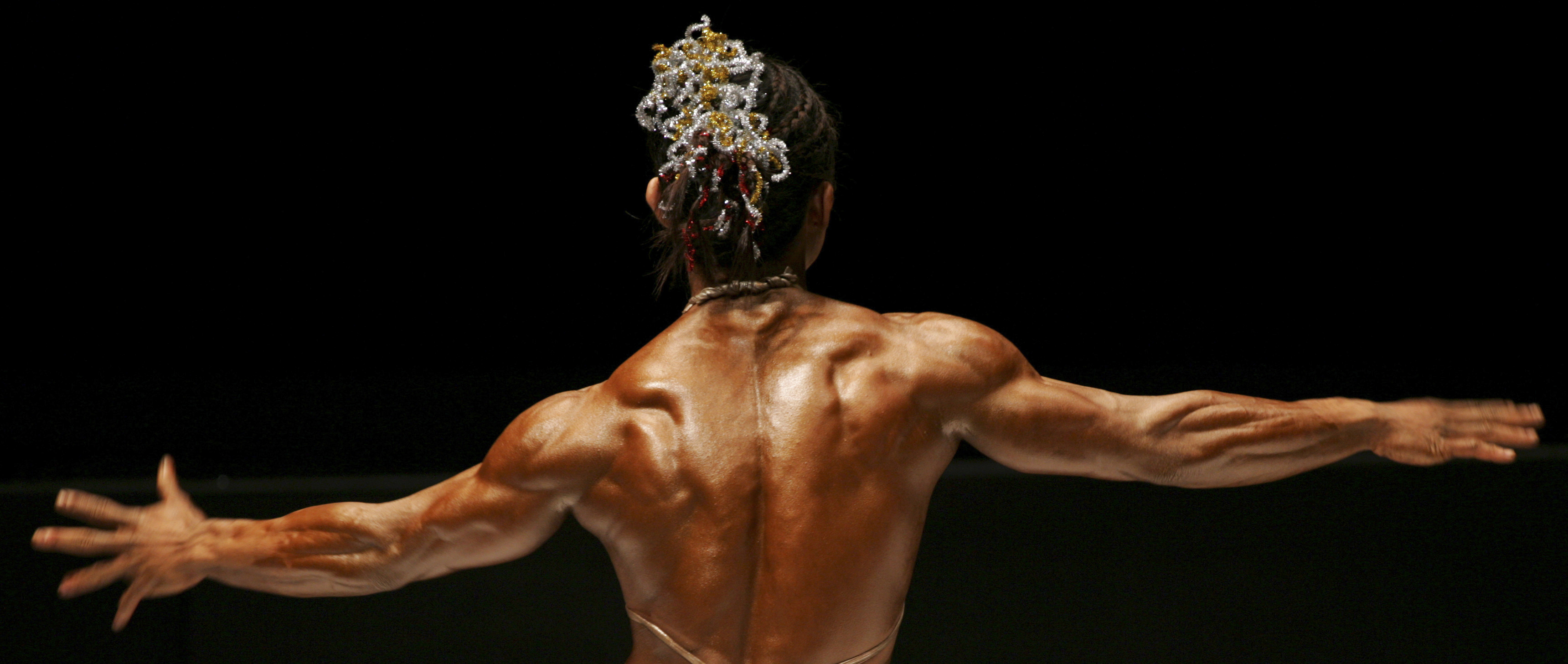
In the months leading up to a show, competitors try to build muscle, which means lots of weight lifting and lots of eating. Then, as the competition draws near, they try to burn fat, which requires more cardio and less heavy lifting and eating.
As Rachel McLish, winner of the inaugural Ms. Olympia bodybuilding competition in 1980, put it: "It's probably one of the most difficult things in the world to do, to build muscle as you're losing fat."
To prepare for a competition, Earles would spend months following a strict exercise plan and diet to develop the right look.
She'd be in the gym six days a week.
Some days, she'd be at the gym by 6 a.m. for a cardio session, and then back in the evening for weight training.
As she got closer to the show, her diet also got a lot stricter, with fewer carbohydrates.
"You’re literally taking flakes of oats out of your bowl and putting them back in the bag," she said. "It opened up a whole other can of worms of [obsessive compulsive disorder] that I never thought I had."

Those potential signs of OCD included fussing endlessly over the photos of herself she would post on social media.
After a training session, or if she found particularly nice lighting, she’d take upward of 25 photos of herself. She would then painstakingly pick just one to post.
Her focus on training crowded out other parts of her life.
Often when her friends would call looking to hang out, she’d tell them she was busy.
"You feel like if you get distracted, you're not 100 per cent committed," she said.
For Earles, a show-ready body looks toned and lean, not bulky like those in the physique or bodybuilding categories.
However, her show-ready body doesn’t last.
You can accept how it is, or not care what people think. But it does take a toll on you.
When a competition is over and she stops restricting her diet, her body returns to its more normal shape, a sometimes painful process that often includes diarrhea and bloating.
After her first competition in July 2016, Earles continued to isolate herself. She skipped parties and other events because she was scared of what people would think of her. She even stopped going to the gym.
"I just felt like people would look at me and think, 'Oh, she let herself go,'" Earles said.
She said she became extremely focused on her face and stomach.
She now suspects those were symptoms of body dysmorphic disorder, a condition that causes a person to become obsessed with certain parts of their body.
But Earles was never diagnosed with the disorder. At the time, her doctor said the problems she was experiencing were normal for someone who had quickly gained weight after being so lean.
Sometimes Earles would binge on frozen yogurt and chips, often in her car so no one else could see.
Other times she would cry uncontrollably, or want to do nothing but sleep.
"You can accept how it is, or not care what people think," she said. "But it does take a toll on you."
'Still a ways to go'
Back in February, right before competition season, Fedel Clarke hosted a day of posing workshops in a small gym tucked away in the basement of an office building on Front Street West in downtown Toronto.
It's a one-room studio with a mirrored wall, slick hardwood floors and warm pot lights.
Clarke, 57, a pro bodybuilder and former competition judge, teaches bodybuilders how to show off the results of their hard work.
Mandy Squires, 35, a lifestyle coach and clothing entrepreneur training for her fifth competition, was the only person to show up for the afternoon coaching session.
She walked into the studio with her two daughters, ages seven and 10. She set them up in the corner with colouring books and an iPad. They barely took notice of where they were, as if this was just part of their regular routine.
Squires wore heavy, high-heeled boots, jeans and a red sweater that seemed stretched to its limit over her muscles.
She competes in the physique category, which requires big muscles, but not quite as big as those in the bodybuilding category.
She looked huge and would probably get even bigger before the competition.
"She has to be careful now," Clarke said. "She could get marked down for looking like a bodybuilder."
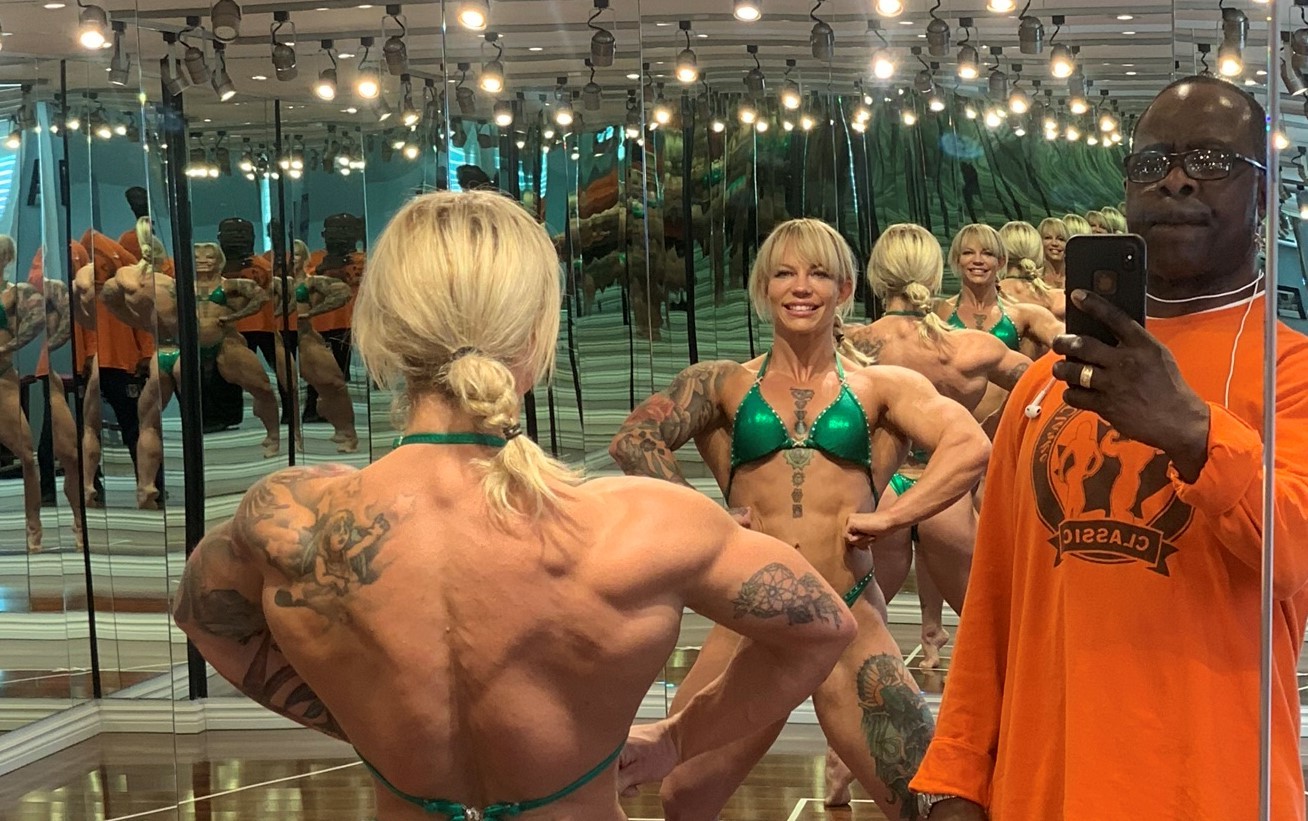
In a competition, Squires has 30 seconds in the presentation round to show five poses: side chest, side tricep, back double bicep, quads and abdominals, and finally, resting pose.
Resting pose is when she stands at the back of the stage, her left toe pointed and wedged up against the arch of her right foot, like a Rockette; her right hand in a fist on her waist; and her left arm hanging, but still flexed, down the side of her body.
There is no actual resting; every muscle is engaged.
After Squires changed into her glittering green show suit, Clarke worked with her like a choreographer setting a routine.
"I'm going to fix that transition for you," he said, after Squires stumbled slightly between two poses.
He rearranged the order until he was satisfied and they started the routine from the top.
After about 20 minutes, Squires was out of breath, sweating and ready to go home.
"You look so different, even from the last time," Kayla Wright, a bikini competitor who works with Clarke, told Squires.
"Still a ways to go," Squires said, punching her left hand into the palm of her right.
It's like if you have a Ziploc baggie with something in it, and you suck all the air out of it.
At the time, Squires was in the gym nearly two hours a day.
She still had about two months to go before the most gruelling stretch of training: "peak week."
Peak week is the final week before a competition, when most competitors dehydrate themselves slowly.
Earles described the process this way: "It's like if you have a Ziploc baggie with something in it, and you suck all the air out of it."
That's how bodybuilders want to look — they describe it as "dry" and "tight."
It's also what the judges are looking for.
Bigger muscles aren't the only goal. The point of dehydration is to make the muscle definition under the skin more visible. When a bodybuilder is dehydrated, their body isn't storing water under the skin, which makes their skin look thinner.
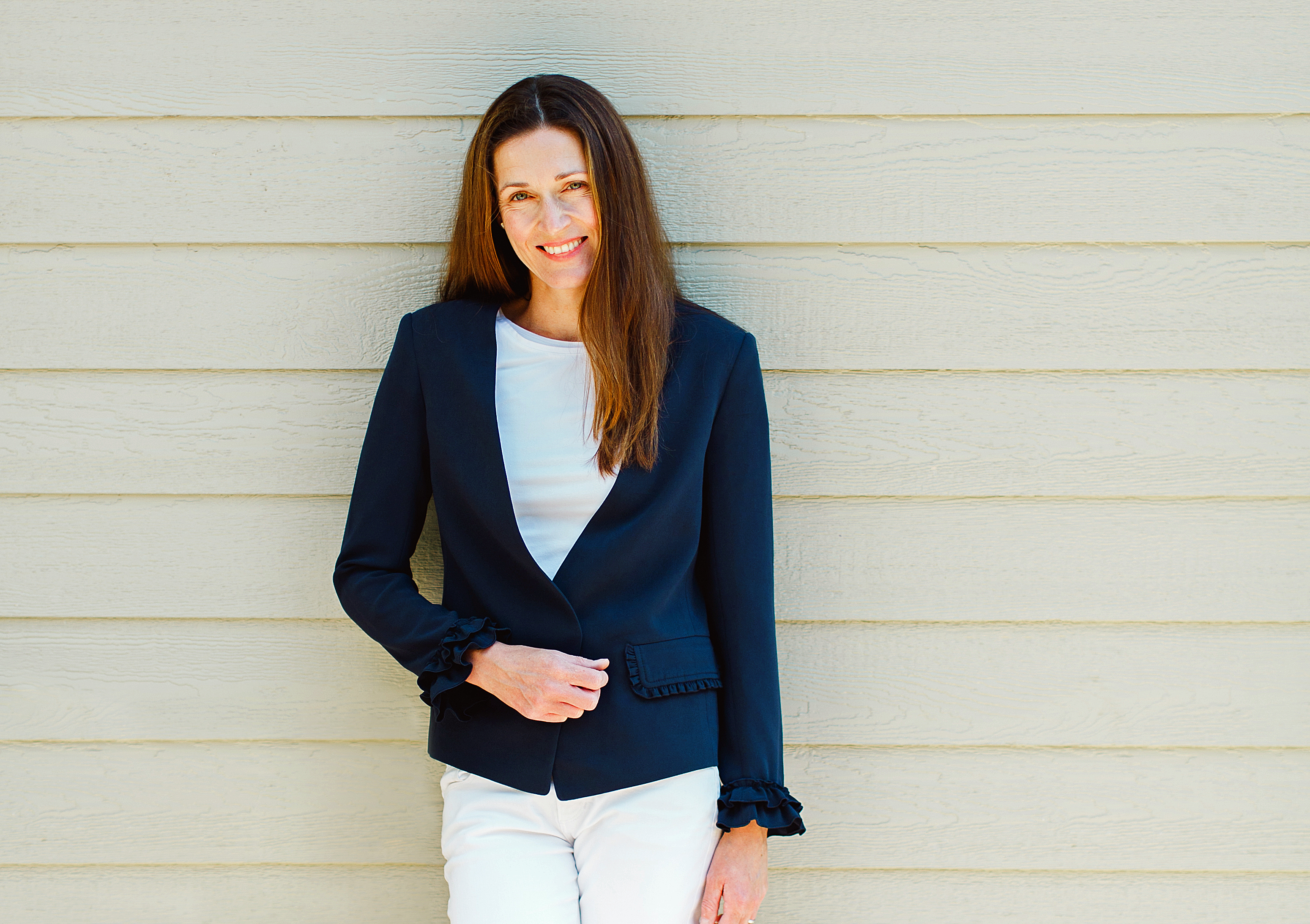
Ashley Leone, a registered dietitian in Toronto who specializes in sports nutrition and works with female bodybuilders, says the health risks of dehydration far outweigh the potential rewards.
She said the loss of electrolytes such as magnesium and potassium can lead to health issues ranging from painful muscle cramps to seizures, heart problems and even kidney failure.
She said dehydration is sometimes practised along with a technique called carb loading, but the combination doesn’t actually make sense — especially for women who compete in the physique and bodybuilding categories and want big muscles.
Carb loading is when a competitor eats extra carbohydrates in the days before a competition, usually after a stretch of eating very little.
Theoretically, this would make muscles look bigger because they would contain more glycogen, which is the means by which carbohydrates are stored in the body. It's an energy source used for sudden bursts of activity — like an intense gym session at 5 a.m.
But in order for muscles to store glycogen, they need liquid — which they are denied during dehydration.
"I'm wondering how effective that technique could be if you’re not drinking sufficient water — they go hand in hand," Leone said.
'The aftermath'
Since bodybuilding is a sport that focuses on looks, Leone said her initial focus with any new client is on possible body image issues and dangerous eating habits.
Given the sport's intense focus on shape and dieting, it's easy to understand how some competitors could develop these kinds of issues, she said.
"But it's difficult to pinpoint when it actually is an issue."
For Leone, one of the biggest indicators of dangerous eating habits is when a woman stops getting her period — as was the case with Earles.
When the body goes into survival mode, she said, the systems that aren't responsible for staying alive — like the reproductive system — shut down first.
In the case of athletes, it's usually a sign they aren't eating enough nutrients to meet their energy needs.
In other sports, Leone said, the athlete would be removed from training right away. But it doesn't work like that for bodybuilders.
"That's the protocol, for example, for soccer players," Leone said. "If they’ve lost their period, they are taken out of competition until their period resumes because of the detrimental effects."
Those effects can include an increased risk of developing osteoporosis and stress fractures.
Leone said part of the problem is too many bodybuilders get their training and diet information from the internet or friends at the gym rather than nutrition professionals.
For Micheline Poncelet, not having the right information is what got her into trouble.

Just a couple days after Poncelet took to the stage in her second bodybuilding competition back in April 2002, she woke up and looked at herself in the mirror and was horrified by her reflection.
The 27-year-old from Ottawa stared at her body. To her, it looked bloated and soft. Far from the lean and muscular form she had spent months building for the figure competition.
The night after the competition, she had gone out for a celebratory dinner with her coach and her mother at a 1950s-style diner. She had a chicken burger and fries, and several glasses of water.
Earlier that day, right after the competition, she ate strawberries, oranges and oatmeal cookies.
On stage, she'd been a size 5 and felt like she was in the best shape of her life.
Her preparation had been far more extreme than for her first competition. In the two months leading up to the second show, she was in the gym at least four hours a day. Her diet was also very strict, and she dehydrated herself during peak week.
Two days after the show, she couldn't fit into her size 8 jeans.
"I told myself that my body was just compensating for all the restrictive eating and drinking and that I did not just get fat overnight," she said.
Poncelet didn't know it at the time, but she was about to descend into a six-month depression that would end her bodybuilding career.
"What we didn't really prepare for well," Poncelet said, "was the aftermath."
Bodybuilders call the aftermath "the rebound."
One strategy to help limit the impact of a post-competition crash is what's known as a reverse diet.
It involves gradually increasing the amount of water and calories the bodybuilder consumes post-competition.
Reverse dieting can be tricky. After weeks of deprivation, it's difficult to resist the urge to eat everything in sight once the competition is finally over.
If the reverse diet isn’t done slowly enough — dietitian Ashley Leone said the pace depends on how extreme the diet was before the show — a bodybuilder can experience digestive problems and extreme weight gain.
That's what happened to Poncelet, who hadn't even tried to reverse diet.
"You go from being, hopefully, what you perceived as being the best shape of your life," Poncelet said, "to all of a sudden being this puffy marshmallow where all of your tissue will hang over the top of your jeans, just because you’re so waterlogged.
"It does a funny thing to your head."
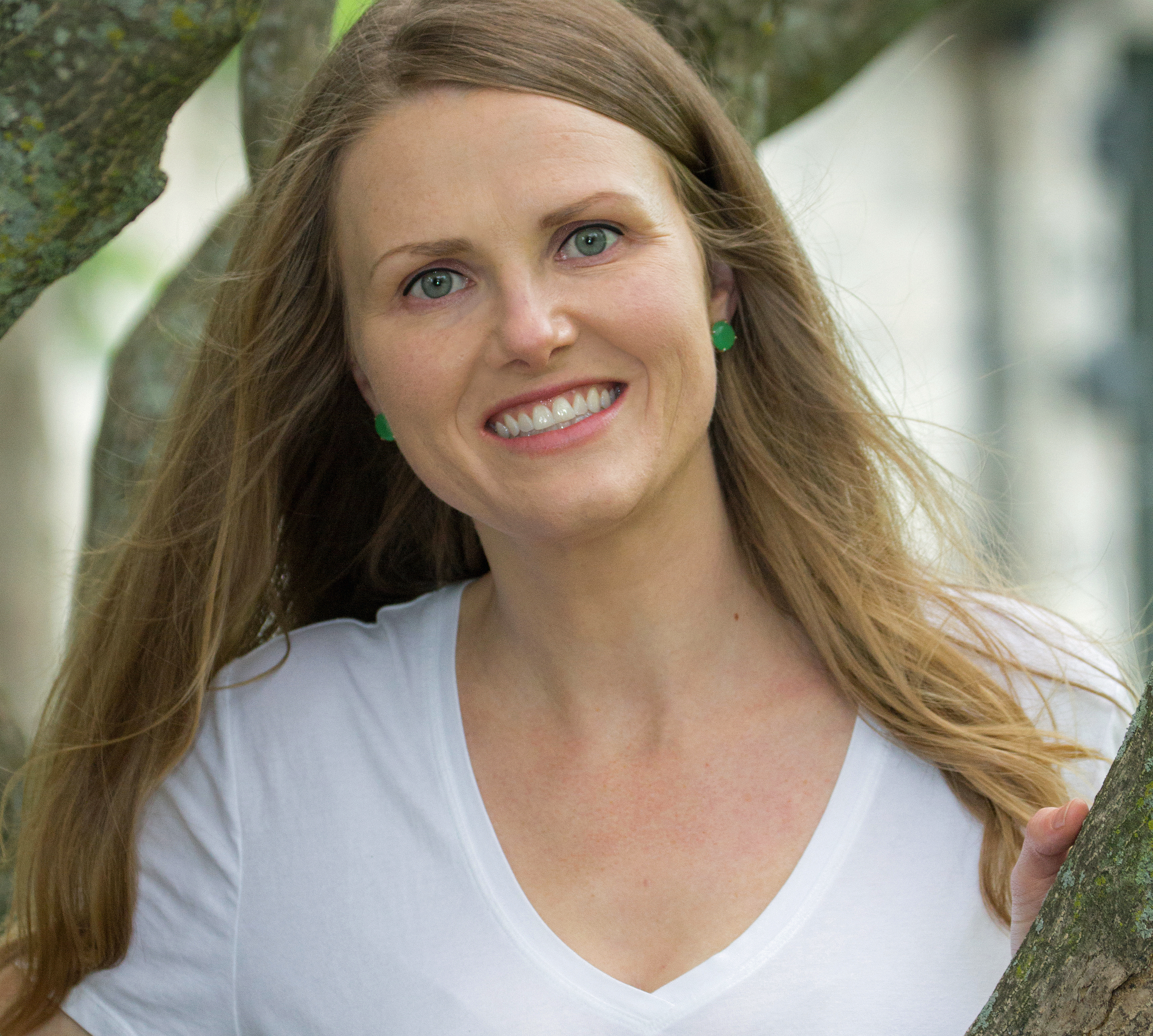
Rebecca Bassett-Gunter, an associate professor of kinesiology and health science at York University, said those "funny things," as Poncelet put it, are common among athletes who are focused on their bodies and attach a significant amount of their self-worth to how they look.
"If you're in the world of bodybuilding," she said, "you're probably going to be immersed in this mentality of 'all or nothing' or 'sacrifice at all costs.'"
Research into the mental health of female bodybuilders is lacking, she said, but there is a lot of research on body image issues generally.
Symptomatic behaviours can include over-exercising and following a rigid diet that lacks nutrients — both of which are common features of the bodybuilding lifestyle.
"Some of their behaviours can take over their lives, really, where it becomes such an obsession that they aren't actually able to enjoy a normal life," Bassett-Gunter said.
"It can become a sort of obsession to engage in these rituals and different practices that allow them to, in their minds, excel at the sport."
The culture of bodybuilding encourages that kind of commitment, but it's that same intense commitment that can also make it more difficult to recognize when someone actually needs help, Bassett-Gunter said.
It makes you feel like you're in control.
Body image issues can lead to depression and anxiety, she said, which can last long after competition day.
Her best advice for competitors is to be open and talk about the mental-health challenges they are facing throughout their training, especially with peers who may be in the same situation.
Proper sleep and nutrition can also be mentally protective, she said.
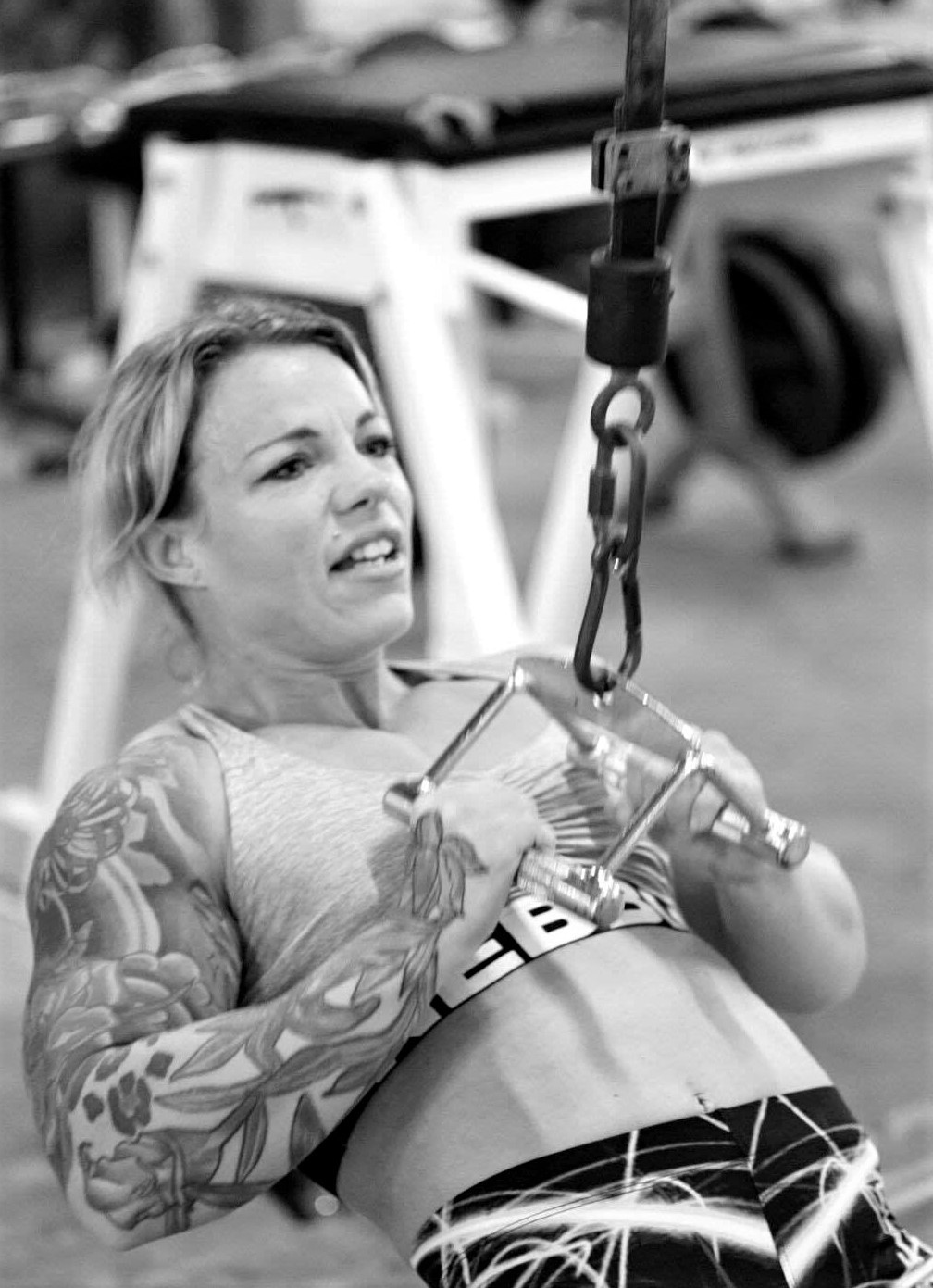
Like a hockey player who decides to continue playing despite several concussions, most bodybuilders aren't scared away by the potential health risks of their sport.
Earles said the gratification of bodybuilding comes from pushing through the training needed to become show-ready.
Despite the health problems she has experienced, she still enjoys competing.
When she became part of the relatively small club of people who can handle elite bodybuilding training, she felt special.
"It makes you feel like you're in control," she said.

That sense of control and self-improvement is part of the sport's appeal for Dana French, 44, a bikini pro from Newfoundland who has competed six times internationally.
She said people who have never competed probably don’t understand what it's all about.
"It's not just to look good," she said. "It's to push yourself to a level where you haven't gone before. It motivates you to be a better person, to work harder."
When you're pushing yourself to the point of passing out on stage, is that really healthy?
Some of those same people who have never competed might also assume most bodybuilders use performance enhancing drugs for that extra push. Bodybuilding, like several other sports that depend on muscles and power, has a reputation for PED use.
It's an issue the sport has yet to totally rein in.
“Unfortunately, PED use is fairly rampant in the industry,” Ultimate Fitness Events said in an email to CBC News.
UFE also noted it is the only bodybuilding organization in Canada to randomly drug-test its competitors and publish the results, including the competitor's name and what they were tested for, online.
It's no secret that PED use can have dangerous side-effects, but what about the potential consequences of extreme dieting and dehydration, or the mental toll the sport takes on some competitors?
When asked about these issues, the Canadian Bodybuilding Federation, a national governing body that hosts amateur competitions, said the sport promotes a healthy lifestyle by encouraging regular exercise and healthy food choices.
In an email to CBC, the federation said bodybuilding itself doesn't cause mental or physical problems, but short-term training designed to achieve fast results can.
"Now, most [competitors] enter the sport seeking almost immediate glorification, and it has been made easier by trainers or coaches willing to offer services to short-cut and fast-track," the federation said.
The federation said competitors used to spend years developing their bodies, and that accelerating the process is not sustainable.
The bodybuilding lifestyle wasn't sustainable for Poncelet.
She gave up the sport years ago and is now a nursing student and a personal trainer in Toronto. She said she's a bit torn in her views about the sport.
"When it comes to bodybuilding, it's not really functional strength that they're developing," she said. "It's just, I stand here and I look good or I look a certain way.
"People are really putting their health at risk."
Poncelet said she appreciates the hard work bodybuilders put in; she knows first-hand what it takes. But she doesn't think the industry promotes a healthy lifestyle.
"When you're pushing yourself to the point of passing out on stage, is that really healthy?"
'I was just done'
In April 2019, five months after Earles's most recent competition, she sat down with her phone and looked at photos of herself on stage.
"I think it's great," she said, inspecting an image.
"But it's insane for show day," she said. "I don’t want to look like that right now."
One photo was taken in 2016, during her first show. She’s in a blue suit, her hair and makeup are done, and she's flashing a wide smile.
"It's too delicate. You don’t have enough energy," she said, after taking a close look at the picture.
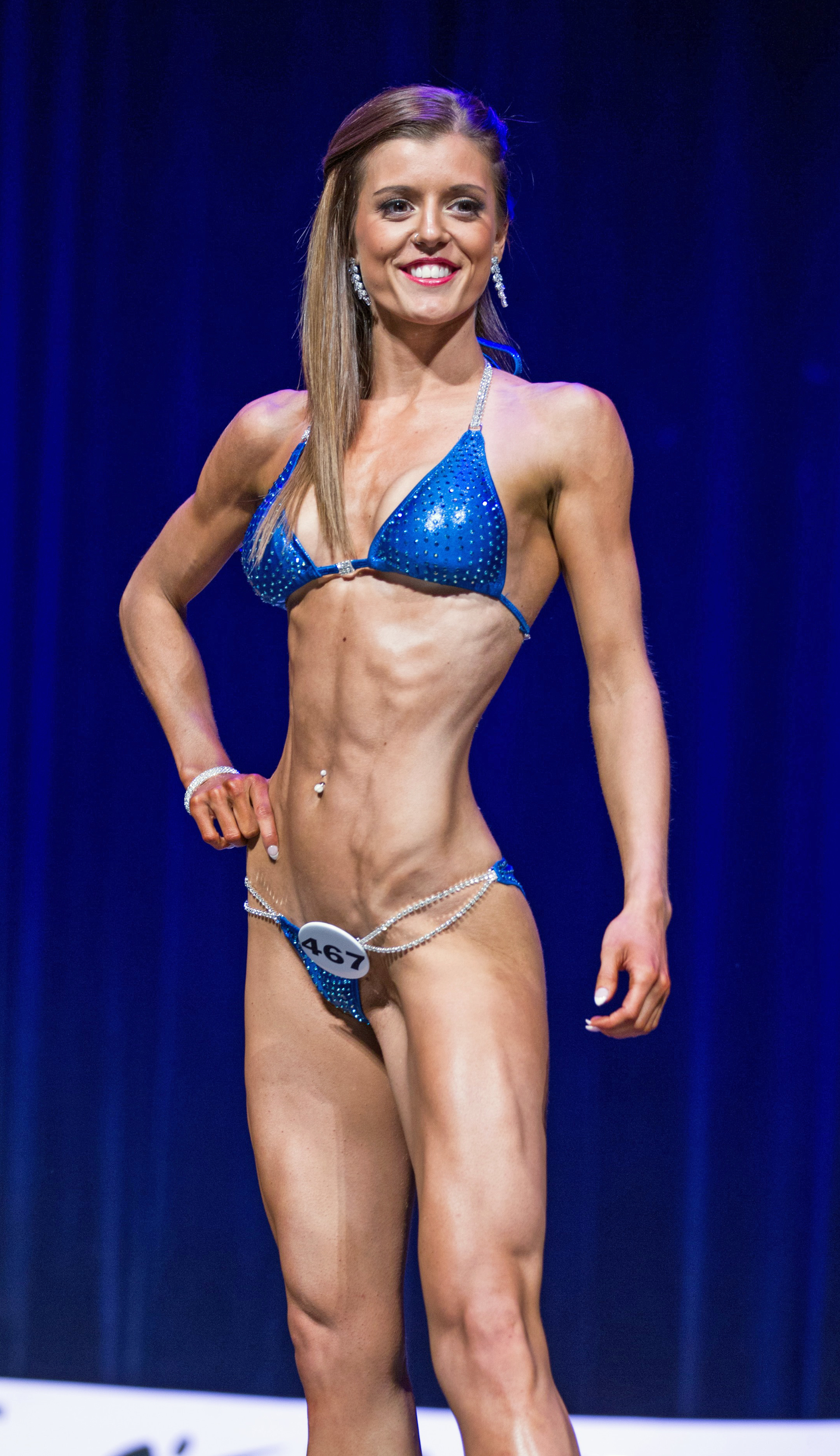
When she gets to a photo from her second show, her hair is bigger, she's wearing a purple suit and more makeup, and has a darker tan.
"Honestly, I was actually pretty tired when I got on stage for this show."
The night before she'd been up late participating in a model search show and had missed her final dose of fish and asparagus.
"Looking at that, I feel like my conditioning was not as good as it could have been," she said. "I feel like going through the last stages of that prep was a struggle. I was just done. I was already over it."
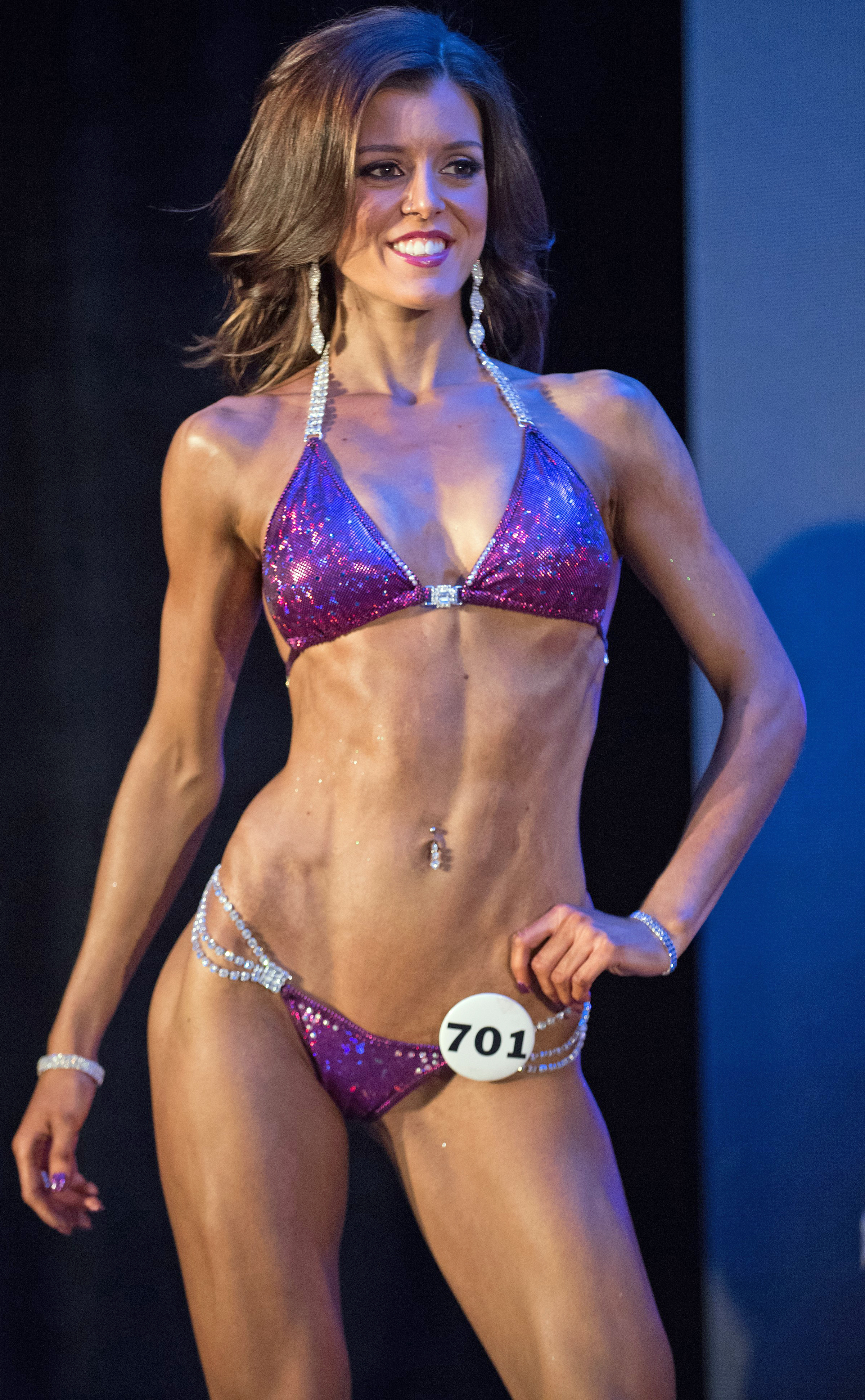
She's not sure if she will compete again.
"I've proven to myself that it didn't work for me," she said. "How many times are you really going to put yourself through that?"
But the kicker, she said, is that she still loves the sport.
She loves the feeling she gets when she steps on stage — the feeling that she belongs to an elite group of people who will put the sport before everything else.
If she does compete again, she'll prepare differently, she said.
"It would be a longer process. I wouldn't squeeze it into 12 weeks."
She also said she would have a better recovery plan.
After her second show in Toronto, she stayed in the city and didn’t reverse diet; it's difficult to deprive yourself when you're on vacation.
She said she would probably plan a trip for a month later, when she was eating normally again and in a healthier mindset.
"I would just work on being regular."
